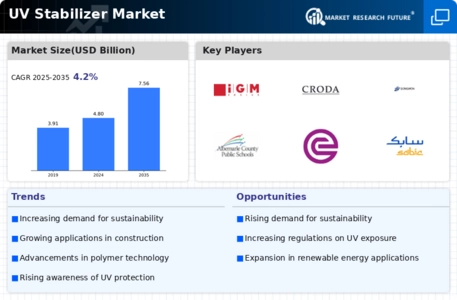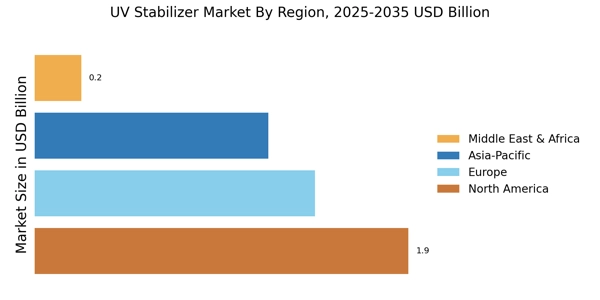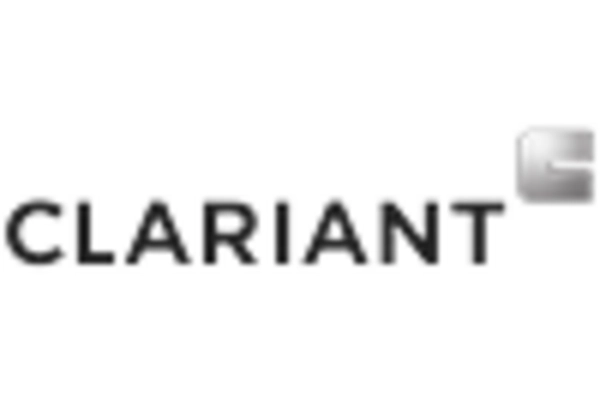Regulatory Compliance and Standards
The UV Stabilizer Market is significantly influenced by stringent regulatory compliance and standards aimed at ensuring product safety and environmental protection. Various regions have implemented regulations that mandate the use of UV stabilizers in products exposed to sunlight, particularly in the plastics and coatings sectors. For example, the European Union has established guidelines that require manufacturers to adhere to specific UV protection standards. This regulatory landscape not only drives the demand for UV stabilizers but also encourages innovation within the industry as companies strive to meet these requirements. Consequently, the UV Stabilizer Market is poised for growth as compliance becomes a critical factor in product development.
Rising Demand for Durable Materials
The UV Stabilizer Market is experiencing a notable increase in demand for durable materials across various sectors. Industries such as construction, automotive, and consumer goods are increasingly utilizing UV stabilizers to enhance the longevity and performance of their products. For instance, the construction sector is projected to grow at a rate of 5.2% annually, driven by the need for materials that withstand harsh environmental conditions. This trend indicates a growing recognition of the importance of UV stabilizers in maintaining product integrity and reducing replacement costs. As manufacturers seek to improve the durability of their offerings, the UV Stabilizer Market is likely to benefit from this heightened focus on material resilience.
Increased Awareness of Environmental Impact
The UV Stabilizer Market is witnessing a shift in consumer awareness regarding the environmental impact of products. As sustainability becomes a priority for both consumers and manufacturers, there is a growing emphasis on using UV stabilizers that are eco-friendly and non-toxic. This trend is particularly evident in the packaging and textile industries, where companies are actively seeking alternatives that minimize environmental harm. The market for bio-based UV stabilizers is expected to expand, reflecting a broader commitment to sustainability. This heightened awareness is likely to drive innovation and investment in the UV Stabilizer Market, as stakeholders aim to align with consumer preferences for environmentally responsible products.
Technological Innovations in UV Stabilizers
The UV Stabilizer Market is benefiting from ongoing technological innovations that enhance the effectiveness and efficiency of UV stabilizers. Recent advancements in polymer chemistry and formulation techniques have led to the development of new stabilizers that offer superior protection against UV degradation. For instance, the introduction of nanotechnology in UV stabilizers has shown promise in improving performance while reducing the quantity needed for effective protection. This innovation not only enhances product quality but also contributes to cost savings for manufacturers. As technology continues to evolve, the UV Stabilizer Market is likely to see an influx of new products that meet the demands of various applications, further driving market growth.
Expanding Applications in Diverse Industries
The UV Stabilizer Market is experiencing expansion due to the increasing range of applications across diverse industries. Beyond traditional uses in plastics and coatings, UV stabilizers are now being integrated into sectors such as agriculture, electronics, and automotive. For example, the agricultural sector is utilizing UV stabilizers in films and coatings to protect crops from harmful UV radiation, thereby enhancing yield and quality. This diversification of applications is expected to propel market growth, as industries recognize the benefits of UV stabilizers in improving product performance and longevity. As new applications emerge, the UV Stabilizer Market is likely to continue evolving, presenting opportunities for innovation and investment.


















Leave a Comment